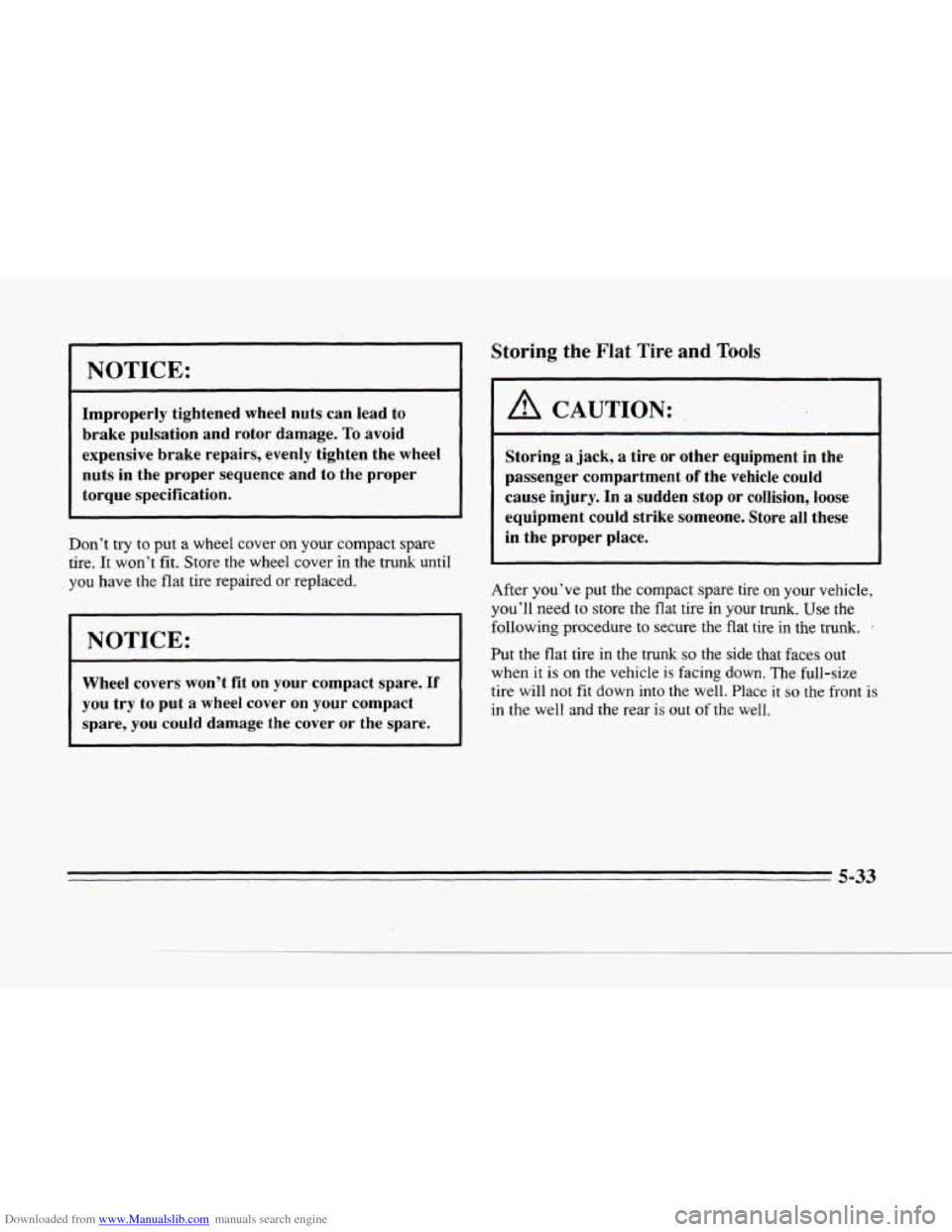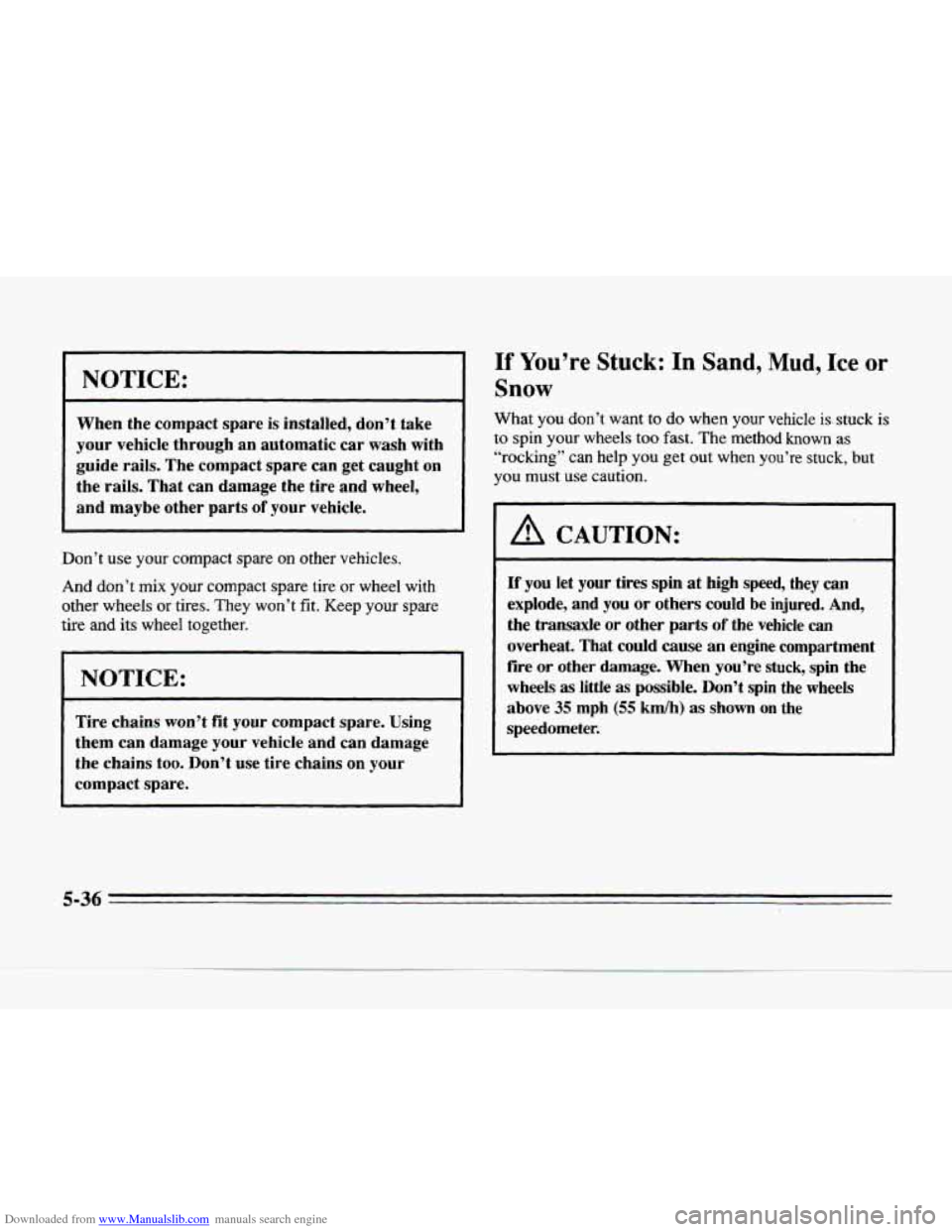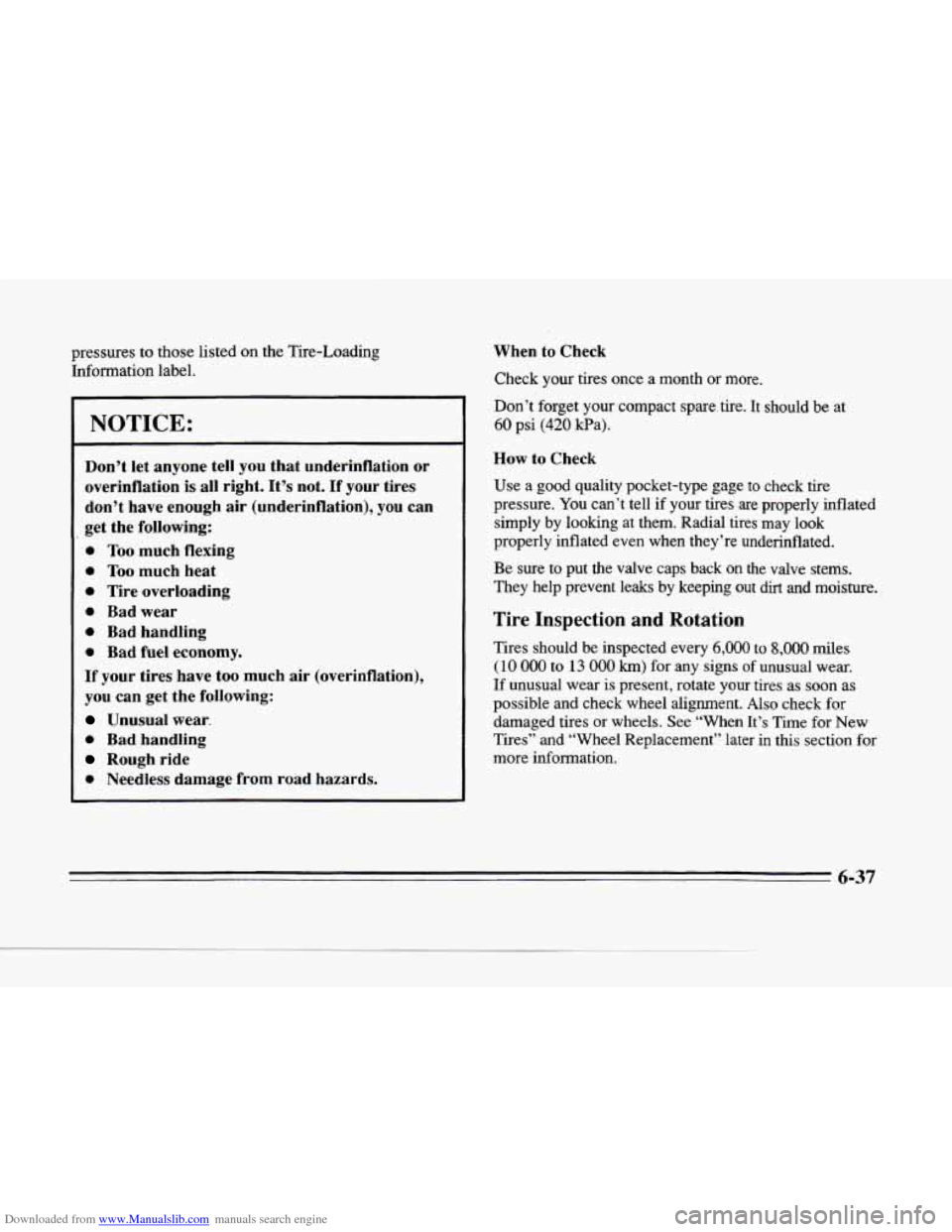Page 247 of 354
Downloaded from www.Manualslib.com manuals search engine Removing the Spare Tire and Tools
The following steps will tell you how to use the jack and
change
a tire.
The equipment you’ll need is in the trunk. Pull the
carpeting from the floor of the trunk. Turn the center
dial on the compact spare cover counterclockwise to
remove it. Lift and remove the cover. (See “Compact
Spare Tire” later in this section for more information
about the compact spare.)
5-26
Page 250 of 354
Downloaded from www.Manualslib.com manuals search engine c-
Removing the Flat Tire and Installing the
Spare Tire
..
1. Using the wheel wrench, loosen all the wheel nuts.
Don't remove them yet.
head a few inches.
2. Turn the jack handle clockwise to raise the jack lift
A CAUTION:
Getting under a vehicle when it is jacked up is
dangerous.
If the vehicle slips off the jack, you
could
be badly injured or killed. Never get under
a vehicle when it is supported only by a jack.
NOTICE:
Raising your vehicle with the jack improperly
positioned will damage the vehicle or
may allow
the vehicle to fall
off the jack. Be sure to fit the
jack lift head into the proper location before
raising your vehicle.
5-29
Page 251 of 354
Downloaded from www.Manualslib.com manuals search engine 11.0 INCHES
(279 mm)
7.0 INCHES
(177 mm)
3. Position the jack under the vehicle and raise the jack
lift head until it fits firmly into the notch in the
vehicle's frame nearest the
flat tire.
Put the compact
spare tire near you.
4. Raise the vehicle by turning the jack handle
clockwise. Raise
the vehicle far enough off the
ground for'the
spare tire to fit under the vehicle.
5. Remove all wheel nuts and take off the flat tire.
5-30
Page 254 of 354

Downloaded from www.Manualslib.com manuals search engine c
NOTICE:
Improperly tightened wheel nuts can lead to
brake pulsation and rotor damage. To avoid
expensive brake repairs, evenly tighten the wheel
nuts in the proper sequence and to the proper
torque specification.
Don’t try
to put a wheel cover on your compact spare
tire.
It won’t fit. Store the wheel cover in the trunk until
you have the
flat tire repaired or replaced.
NOTICE:
Wheel covers won’t fit on your compact spare. If
you try to put a wheel cover on your compact
spare,
you could damage the cover or the spare.
Storing the Flat Tire and Tools
CAUTION:
Storing a jack, a tire or other equipment in the
passenger compartment
of the vehicle could
cause injury. In
a sudden stop or collision, loose
equipment could strike someone. Store all these
in the proper place.
After you’ve put the compact spare tire
on your vehicle,
you’ll need
to store the flat tire in your trunk. Use the
following procedure to secure the
flat tire in the trunk.
Put the flat tire in the trunk so the side that faces out
when it is on the vehicle is facing down. The full-size
tire will not fit down into the well. Place
it so the front is
in the well and the rear is out of the well.
5-33
Page 255 of 354
Downloaded from www.Manualslib.com manuals search engine Secure the tire with the stud cap that was used to hold
the. compact spare in place. Store the cover as far
forward as possible.
Storing the Spare Tire and Tools
b I
I A CAUTION:
Storing a jack, a tire or other equipment in the
passenger compartment
of the vehicle could
cause injury. In
a sudden stop or coilision, loose
equipment could strike someone. Store all these
in the proper place.
c
Page 256 of 354
Downloaded from www.Manualslib.com manuals search engine P
c
The compact spare is for temporary use only. Replace
the compact spare tire with
a full-size tire as soon as you
can. See the storage instructions label to replace your
compact spare into your trunk properly.
Compact Spare Tire
Although the compact spare tire was fully inflated when
your vehicle was new, it can lose
air after a time. Check
the inflation pressure regularly.
It should be 60 psi
(420 kPa).
After installing the compact spare
on your vehicle, you
should stop as soon as possible
and make sure your
spare tire is correctly inflated. The compact spare. is
made to perform well at posted speed limits for
distances up to
3,000 miles (5 000 km), so you can
finish your trip and have your full-size tire repaired
or
replaced where you want. Of course, it’s best to replace
your spare with a full-size tire as
soon as you can. Your
spare will last longer and be in
good shape in case you
need
it again.
5-35
Page 257 of 354

Downloaded from www.Manualslib.com manuals search engine NOTICE:
When the compact spare is installed, don’t take
your vehicle through
an automatic car wash with
guide rails. The compact spare can get caught
on
the rails. That can damage the tire and wheel,
and maybe other parts
of your vehicle.
Don’t use your compact spare on other vehicles.
And don’t mix your compact spare tire
or wheel with
other wheels
or tires. They won’t fit. Keep your spare
tire
and its wheel together.
NOTICE:
Tire chains won’t fit your compact spare. Using
them can damage your vehicle and can damage
the chains too. Don’t use tire chains
on your
compact spare.
If You’re Stuck: In Sand, Mud, Ice or
Snow
What you don’t want to do when your vehicle is-stuck is
to spin your wheels too fast. The method known as
“rocking’’ can help you get out when you’re stuck,
but
you must use caution.
A CAUTION:
If you let your tires spin at high speed, they can
explode, and you or others could
be injured. And,
the transaxle or other parts
of the vehicle can
overheat. That could cause an engine compartment
fire or other damage. When you’re
stuck, spin the
wheels as little
as possible. Don’t spin the wheels
above
35 mph (55 kdh) as shown on the
speedometer.
5-36
Page 296 of 354

Downloaded from www.Manualslib.com manuals search engine c
rc
pressures to those listed on the Tire-Loading
Information label.
NOTICE:
Don’t let anyone tell you that underinflation or
overinflation
is all right. It’s not. If your tires
don’t have enough
air (underinflation), you can
get the following:
0 Too much flexing
0 Too much heat
0 Tire overloading
0 Bad wear
0 Bad handling
0 Bad fuel economy.
If your tires have too much air (overinflation),
you can get the following:
Unusual wear.
0 Bad handling
Rough ride
0 Needless damage from road hazards. When to
Check
Check
your tires once a month or more.
Don’t forget your compact spare.
tire. It should be at
60 psi (420 kPa).
How
to Check
Use a mod quality pocket-type gage to check tire
pressure. You can’t tell if your tires are properly inflated
simply by looking at them. Radial tires may look
properly inflated even when they’re underinflated.
Be sure to put the valve caps back
on the valve stems.
They help prevent leaks by keeping out dirt
and moisture.
Tire Inspection and Rotation
Tires should be inspected every 6,000 to 8,000 miles
( 10 000 to 13 000 km) for any signs of unusual wear.
If unusual wear is present, rotate your tires as soon as
possible and check wheel alignment. Also check for
damaged tires or wheels. See
“When It’s Time for New
Tires” and “Wheel Replacement” later
in this section for
more information.
6-37